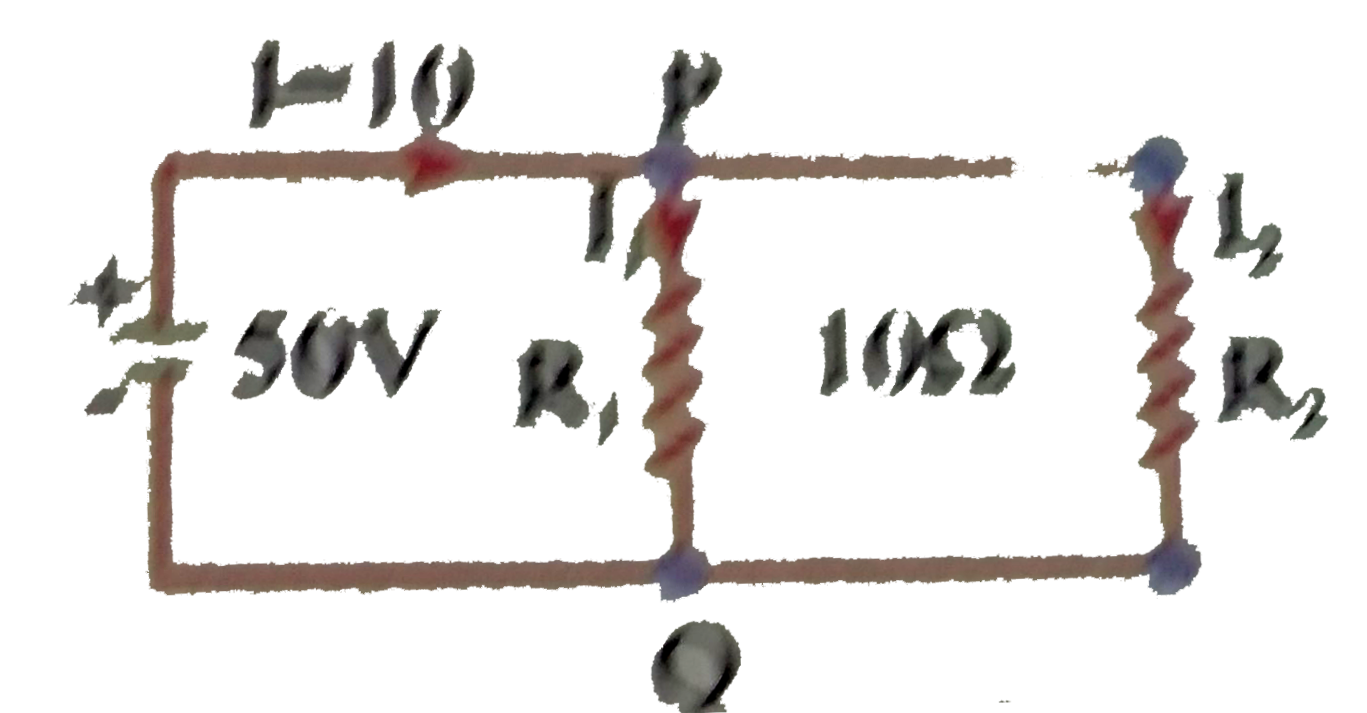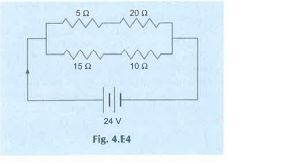The current enters at A and leaves at F. The values of some resistance are shown. What should be the value of resistance AB so that no current will flow through CB?

A
(57)R
B
R3
C
(53)R
D
(59)R
Video Solution
Text Solution
The correct Answer is:C
Let VA−VF=V
if VA−VC=VA−VB
Equivalent resistance along ADCEF is
R(27+37+17+17)=R (Remove CB)
Along ADCEF, VA−VF=V=I1R
V1=VR
VA−VC=I157R=57R=5V7=VA−VB
[From Eq. (i)]
Along path ABF, equivalent resistance is
RAB+23R
VA−VF=V=I2(RAB+23R)
or I2=VRAB+23RorVA−VB=I2RAB−VA−VC
⎡⎣VRAB+23RRAB⎤⎦=57R [from Eq.(ii)]
or RAB=53R
|
Topper's Solved these Questions
- ELECTRIC CURRENT AND CIRCUITBOOK - CENGAGE PHYSICSCHAPTER - ELECTRIC CURRENT AND CIRCUITEXERCISE - Multiple Correct
16 Videos
- ELECTRIC CURRENT AND CIRCUITBOOK - CENGAGE PHYSICSCHAPTER - ELECTRIC CURRENT AND CIRCUITEXERCISE - Comprehension
35 Videos
- ELECTRIC CURRENT AND CIRCUITBOOK - CENGAGE PHYSICSCHAPTER - ELECTRIC CURRENT AND CIRCUITEXERCISE - Subjective
29 Videos
- ELECTRIC CURRENT & CIRCUITSBOOK - CENGAGE PHYSICSCHAPTER - ELECTRIC CURRENT & CIRCUITSEXERCISE - Kirchhoff s law and simple circuits
15 Videos
- ELECTRIC FLUX AND GAUSS LAWBOOK - CENGAGE PHYSICSCHAPTER - ELECTRIC FLUX AND GAUSS LAWEXERCISE - MCQ s
38 Videos
Similar Questions
Knowledge Check
The current enters at A and comes out at D. Some of the resistance are shown. What should be resistance of wire CB so that it draws double of the current that enters the wire BF.
 A(910)RB(89)RC(79)RD(320)R
A(910)RB(89)RC(79)RD(320)RThe potential difference between A and B is V. The values of some resistances are shown. The other resistance are equal in values. What should be the value of each of these resistances so that current in circuit is V/3R.
 AR/3BRCR/6D3R
AR/3BRCR/6D3RIn the circuit shown, the galvanometer shows zero current. The value of resistance R is :
 A1ΩB2ΩC4ΩD9Ω
A1ΩB2ΩC4ΩD9Ω

The magnitude of resistance X in the circuit shown in the given figure , when no current flows through the 5Ω resistor is
View SolutionCurrent enters or leaves the electrolyte through _____
View Solution
The value of current in the 6Ω resistance is :
View SolutionIn the given circuit, the resistances are given in ohm. The current through the 10Ω resistance is 3 A while that through the resistance X is 1 A. No current passes through the galavanometer. The values of the unknown resistances X and Y are respectively (in ohm)

View SolutionIf internal resistance of cell is negligible, then current flowing through the circuit is

View Solution


